Abstract
Positive behavioral contrast was assessed in two experiments with young infants using multiple conjugate reinforcement schedules. Reinforcement was produced by footkicks which activated the objects of an overhead crib mobile in a manner proportional to the vigor and rate of responding. Distinctive color/pattern cues on the sides of the objects served as discriminative stimuli for components of the multiple schedule. In Experiment 1, infants were trained with one cue (S+) only before insertion of S+ into a multiple schedule with an extinction component. A control group received S+ throughout all sessions. In Experiment 2, a multiple schedule was introduced at the outset, and responses in both components were reinforced before the introduction of extinction in the second component. In a final phase, reinforcement was reintroduced into the second component. Positive behavioral contrast occurred in both experiments. Response reduction in the extinction component was seen only in individual relative response curves. In both experiments, negative emotional behaviors accompanied the extinction component, and in Experiment 1, cooing accompanied presentations of S+.
Full text
PDF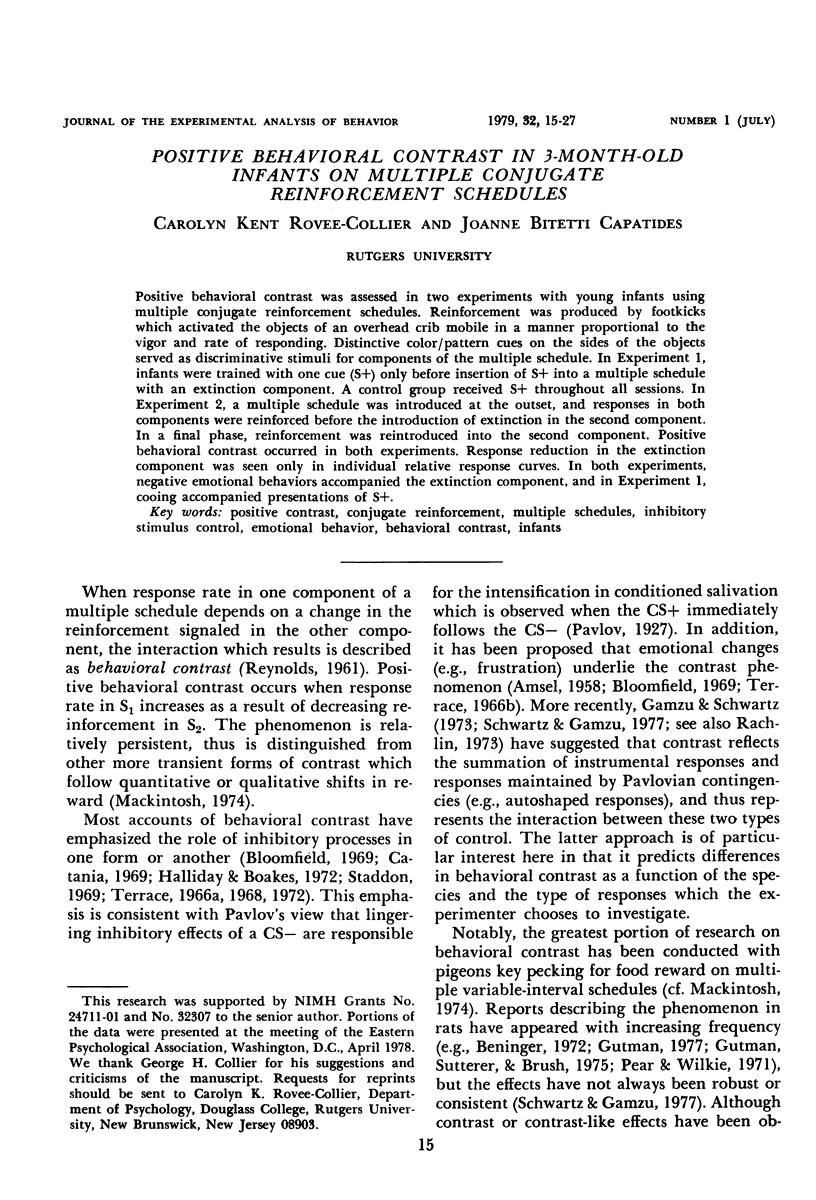
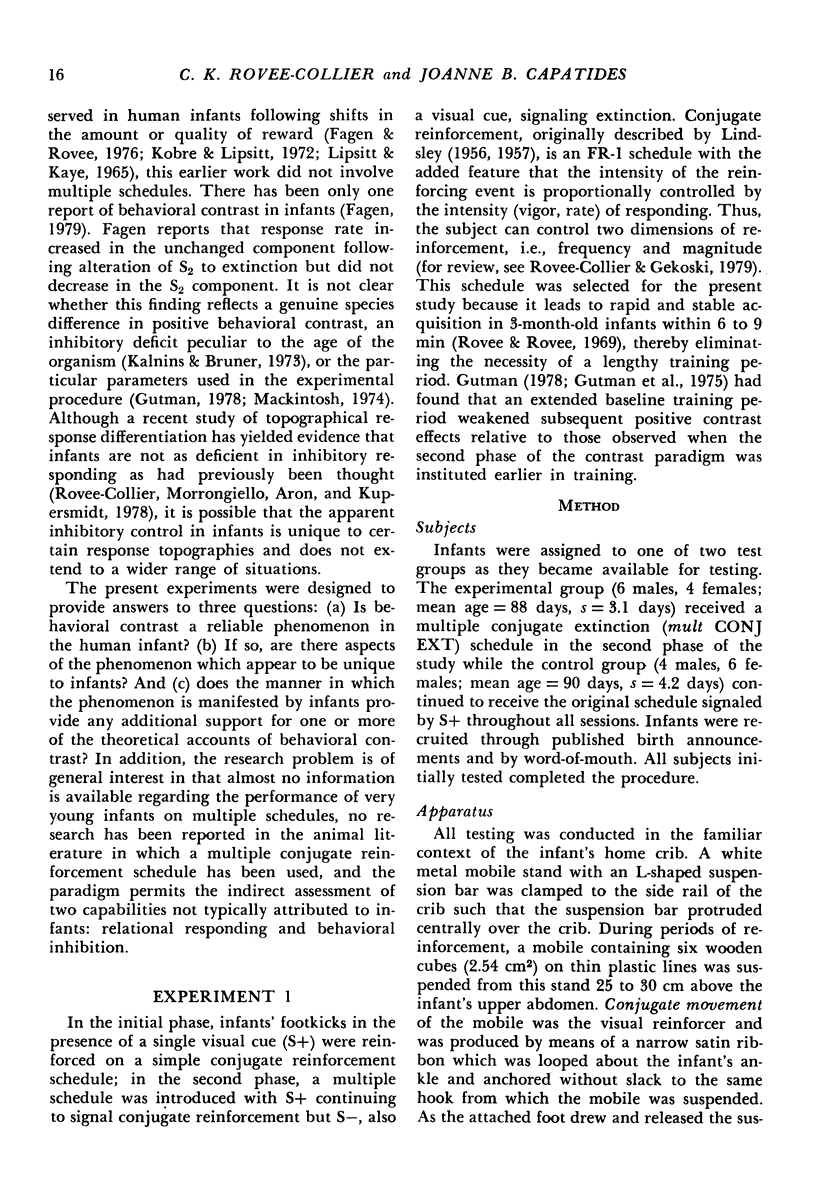
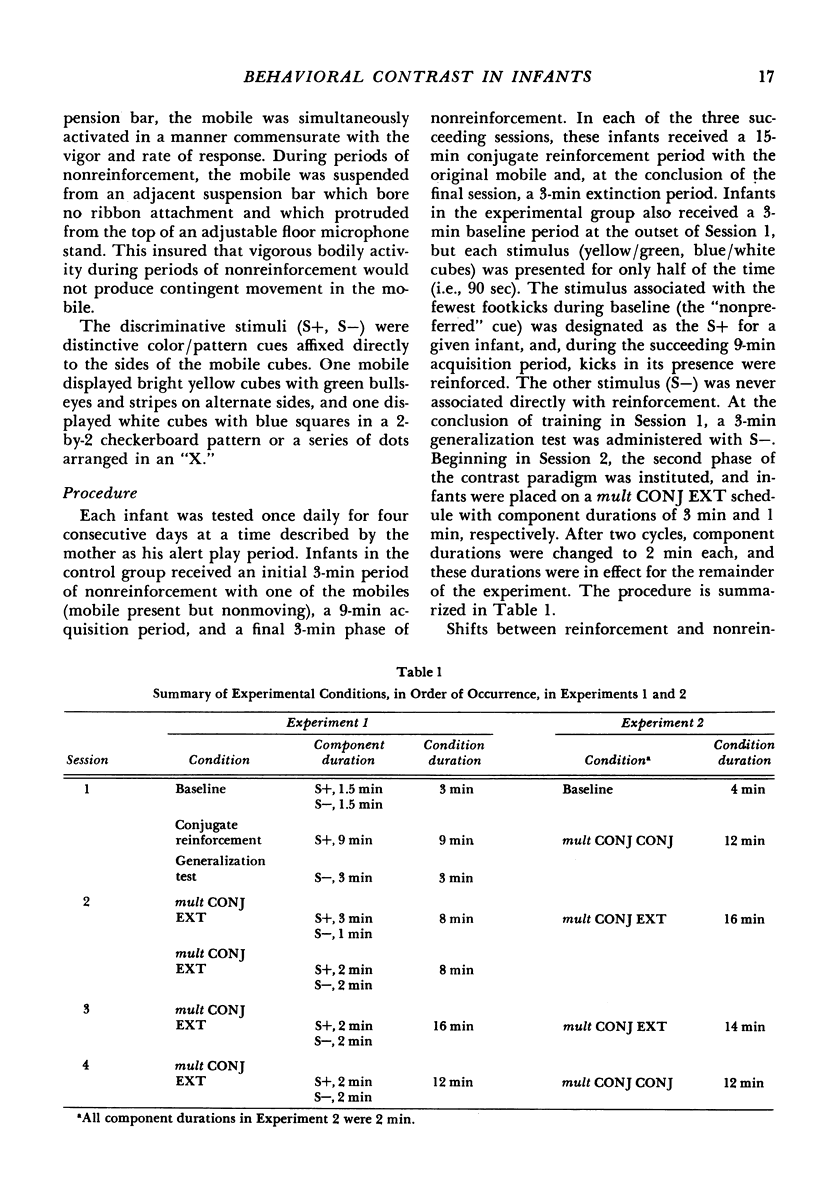
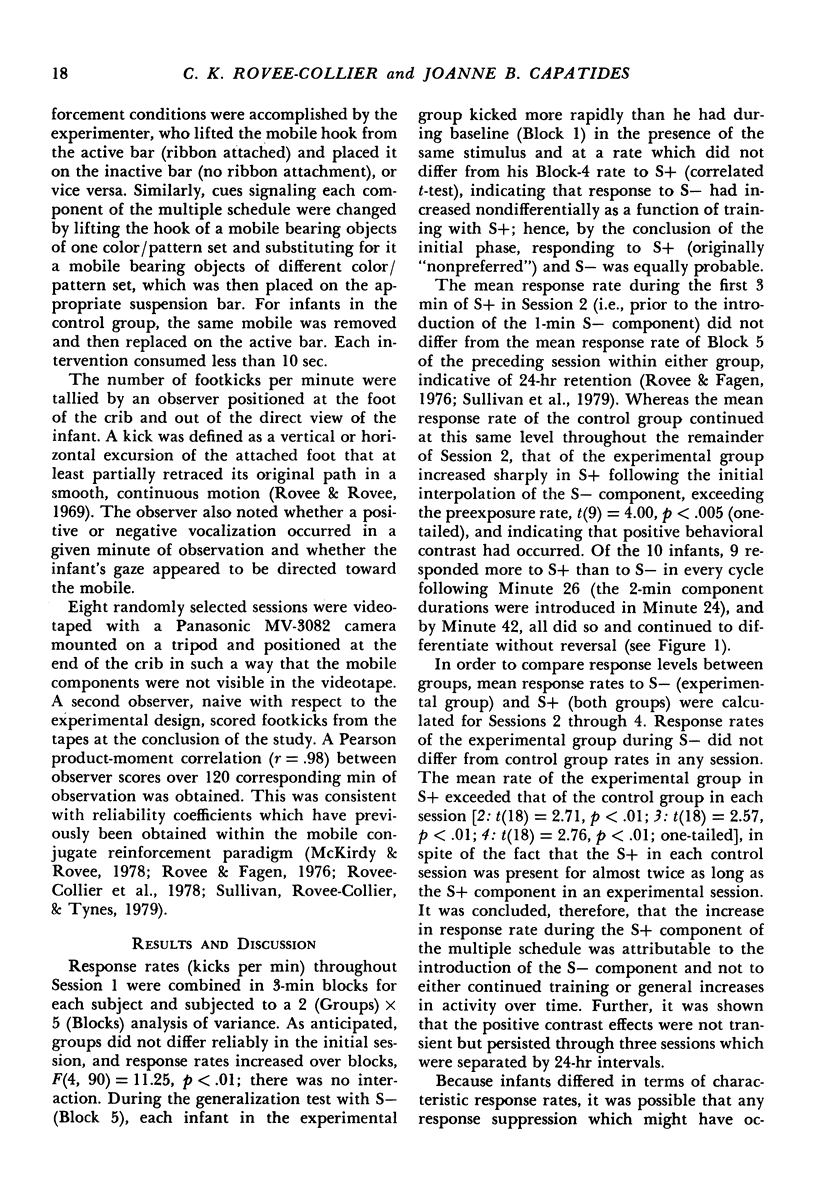
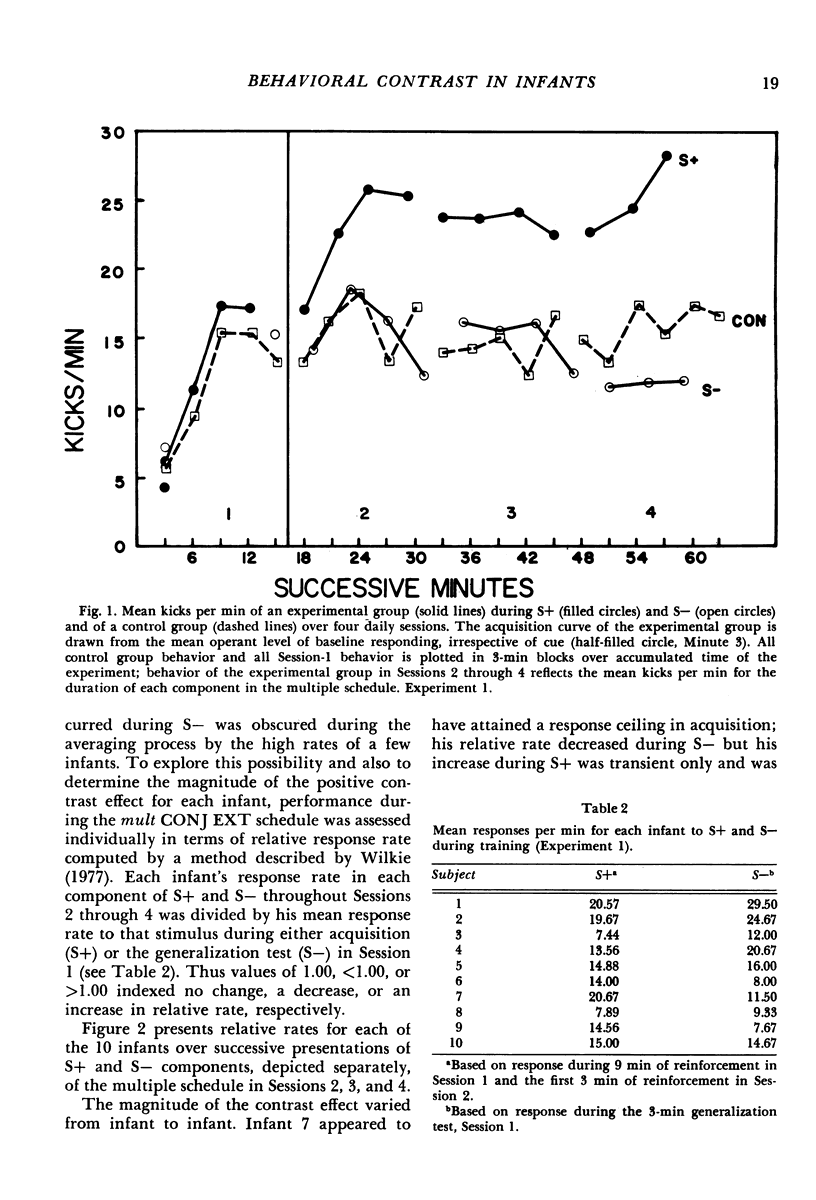
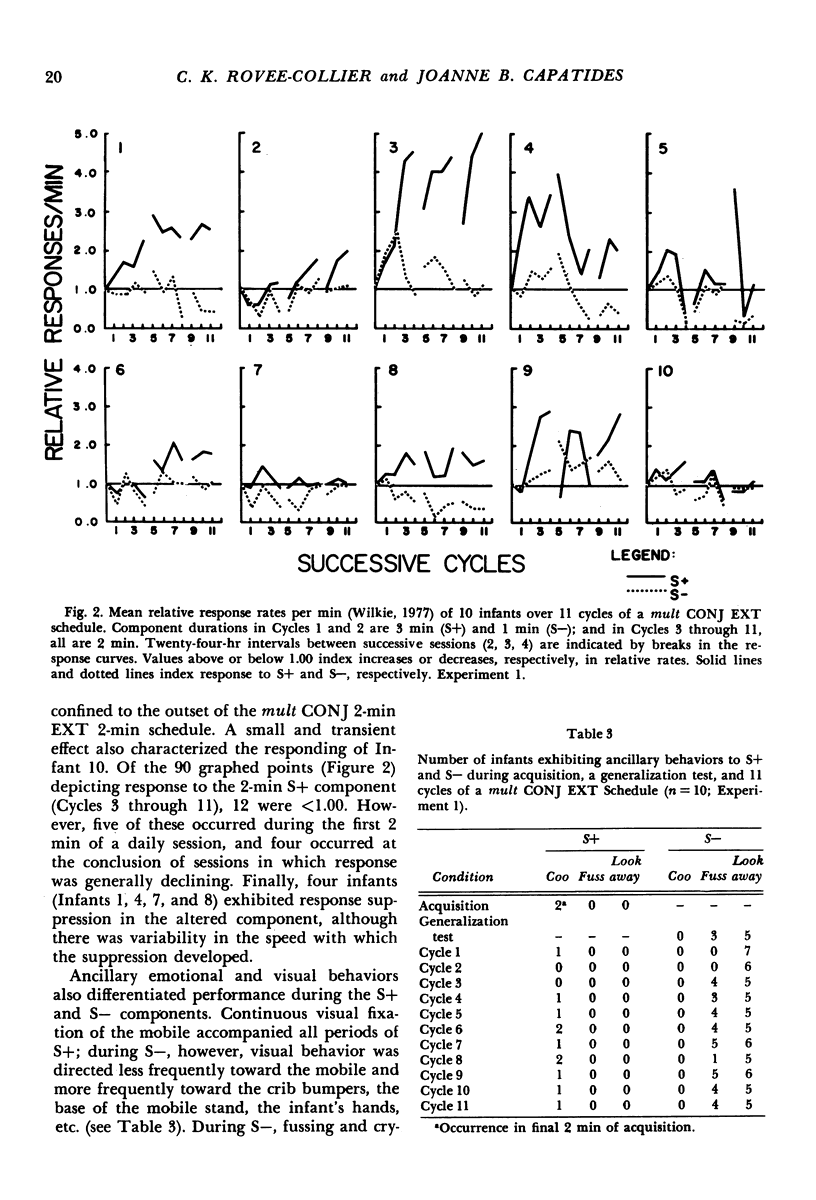
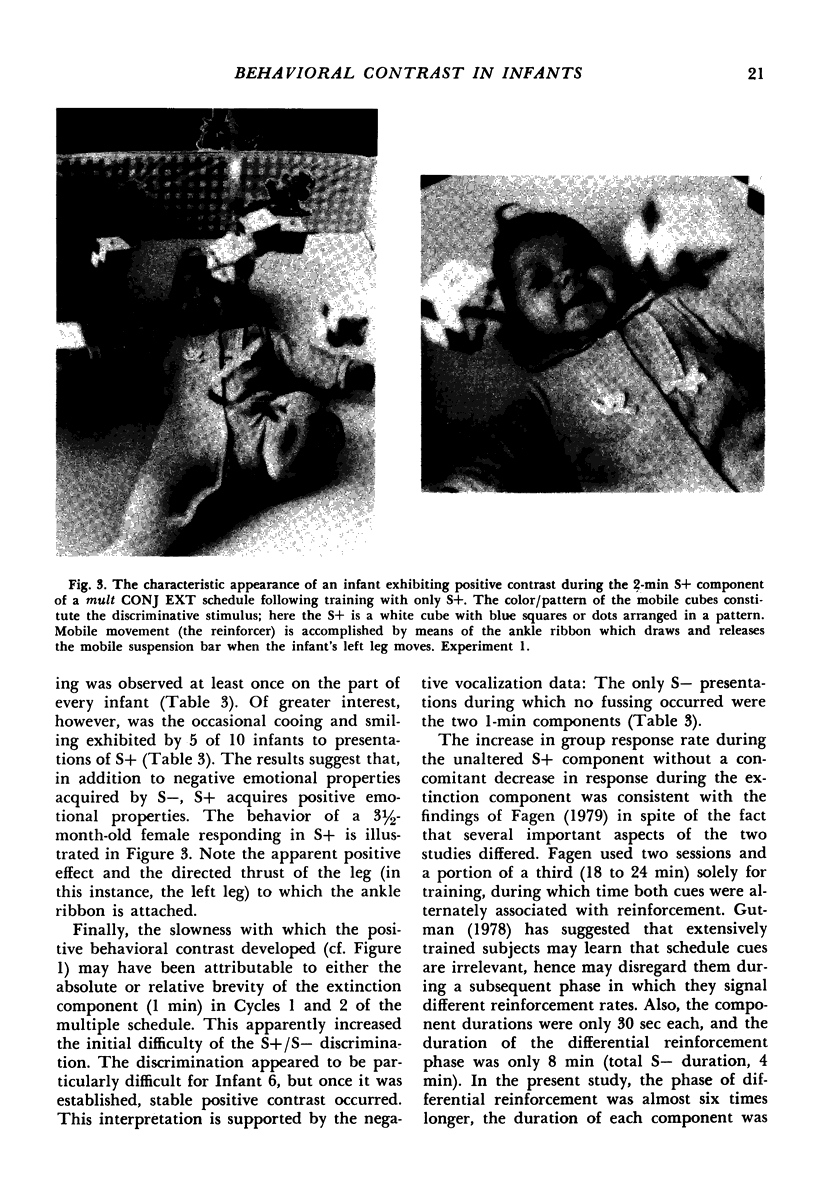
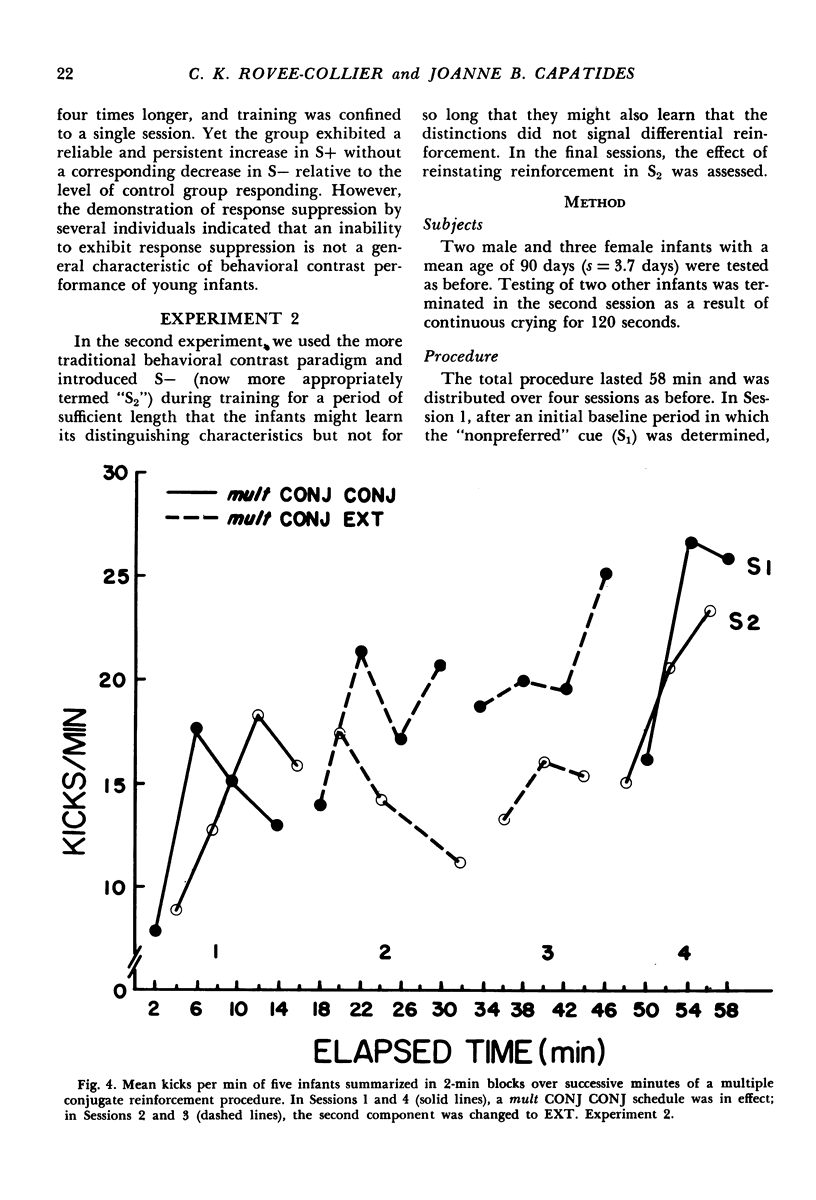
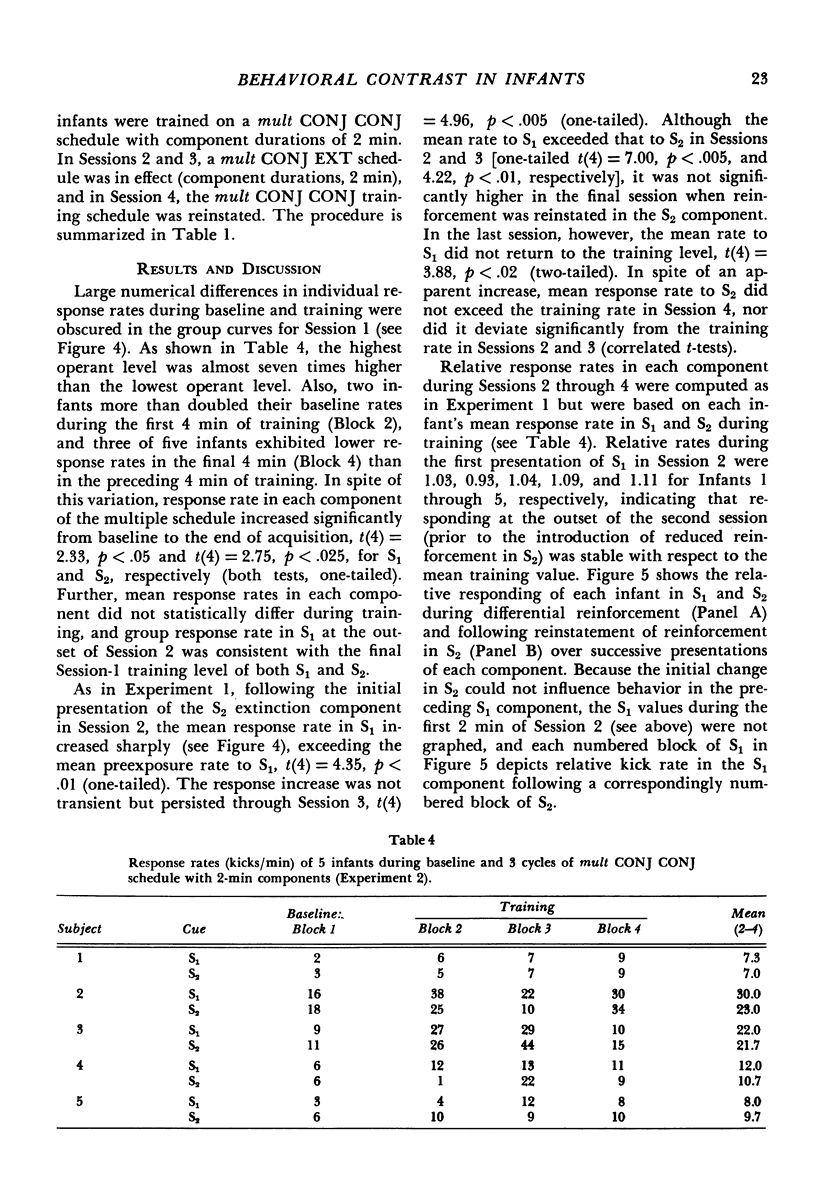

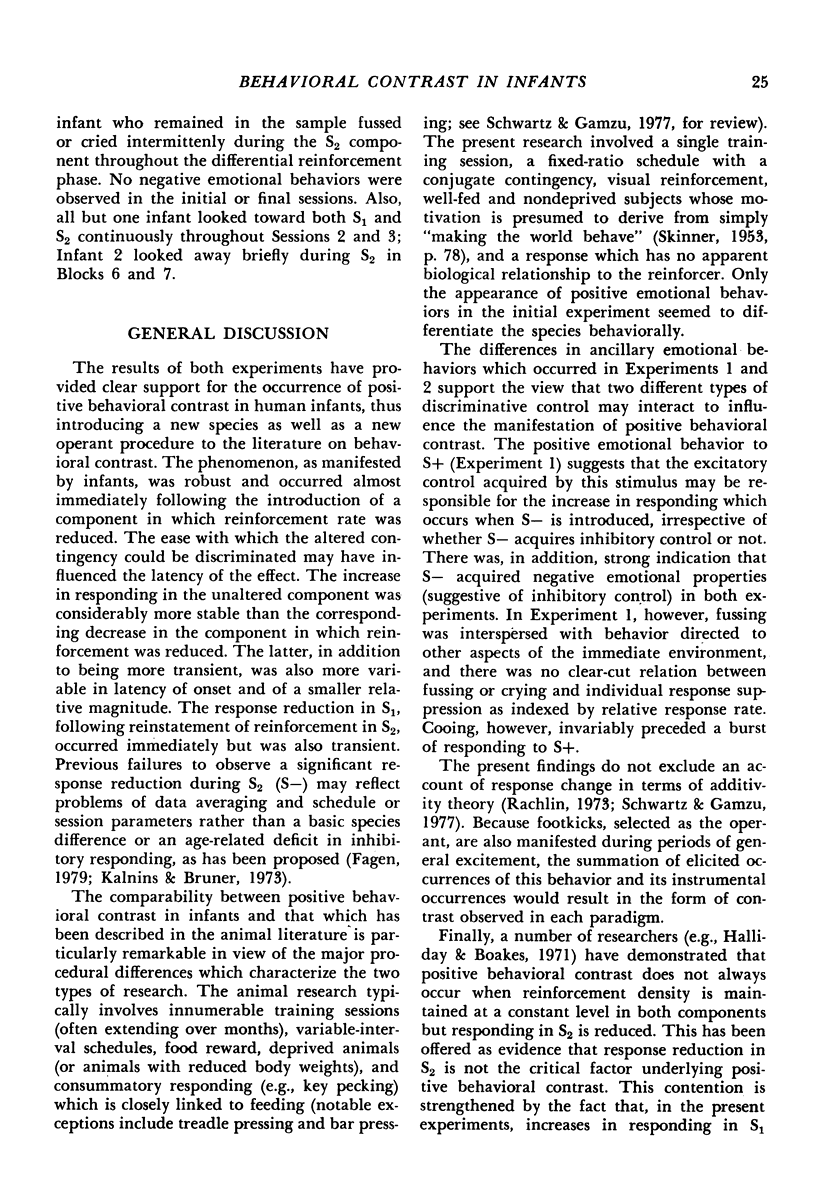
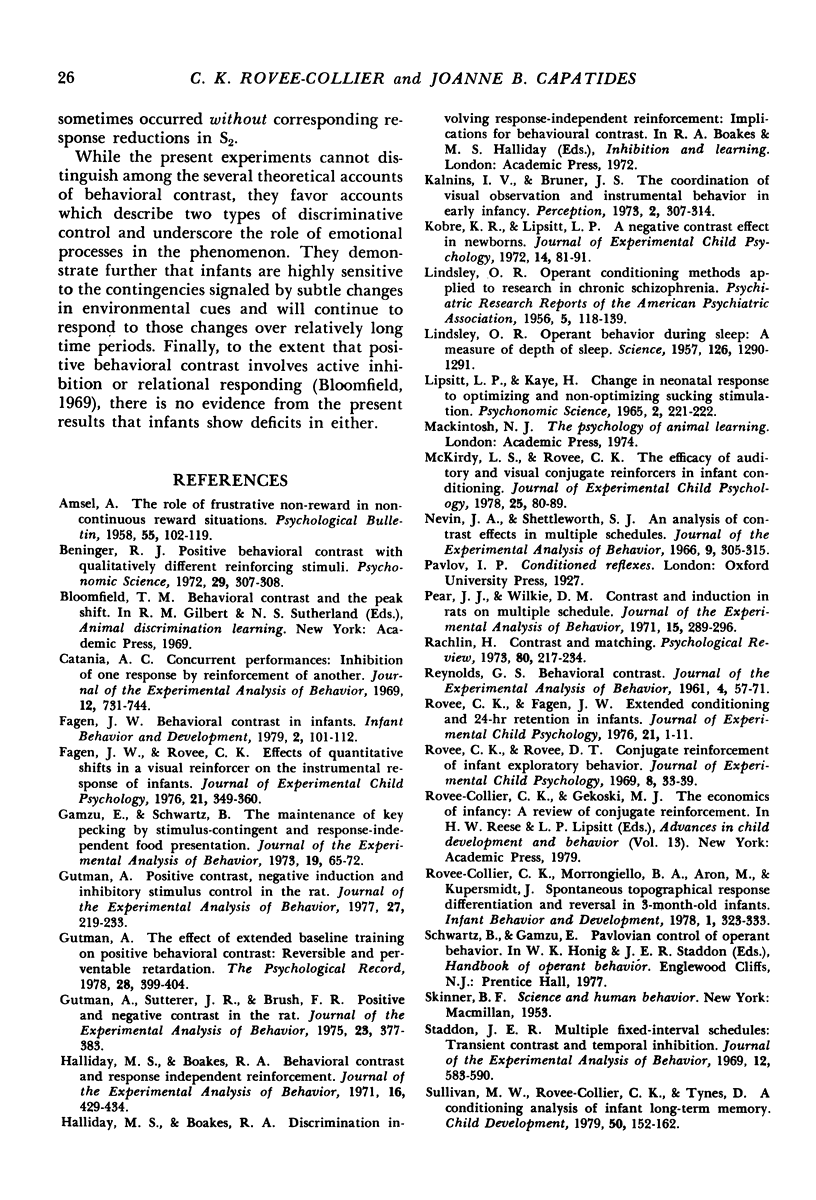
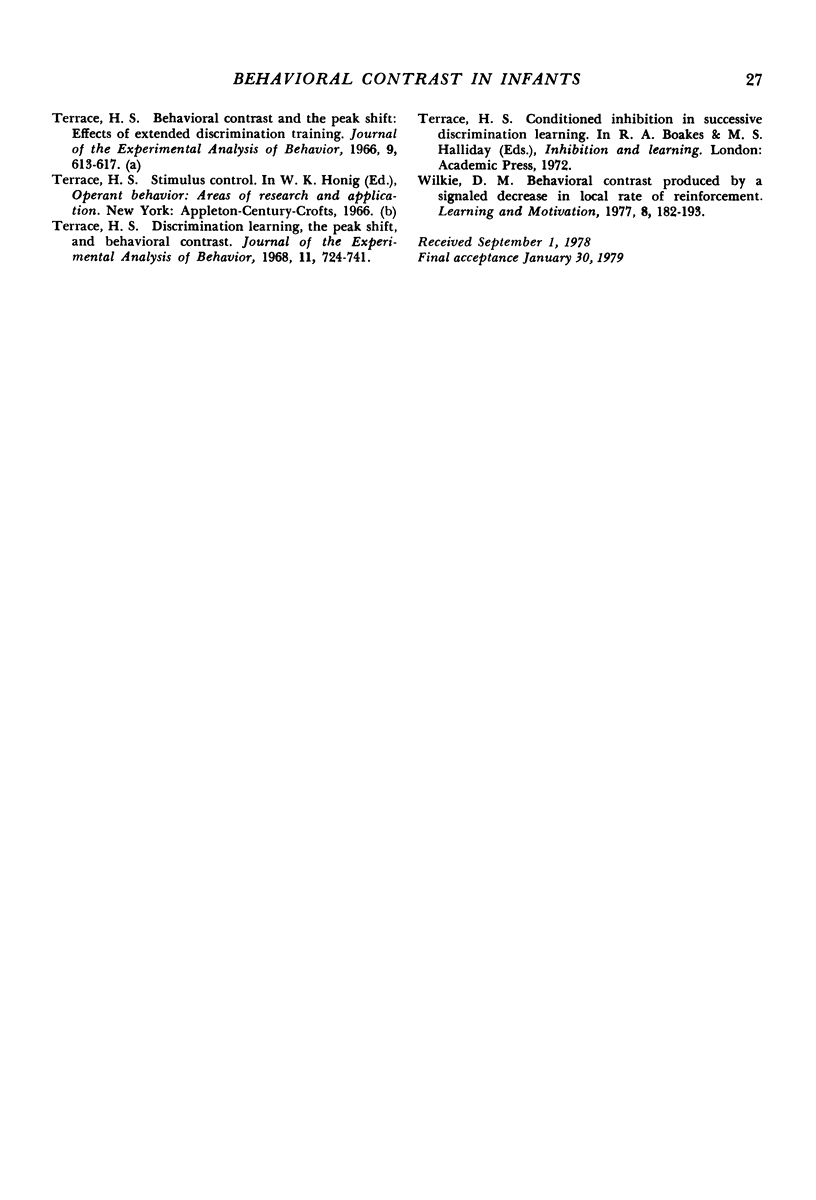
Images in this article
Selected References
These references are in PubMed. This may not be the complete list of references from this article.
- AMSEL A. The role of frustrative nonreward in noncontinuous reward situations. Psychol Bull. 1958 Mar;55(2):102–119. doi: 10.1037/h0043125. [DOI] [PubMed] [Google Scholar]
- Catania A. C. Concurrent performances: inhibition of one response by reinforcement of another. J Exp Anal Behav. 1969 Sep;12(5):731–744. doi: 10.1901/jeab.1969.12-731. [DOI] [PMC free article] [PubMed] [Google Scholar]
- Fagen J. W., Rovee C. K. Effects of quantitative shifts in a visual reinforcer on the instrumental response of infants. J Exp Child Psychol. 1976 Apr;21(2):349–360. doi: 10.1016/0022-0965(76)90048-5. [DOI] [PubMed] [Google Scholar]
- Gamzu E., Schwartz B. The maintenance of key pecking by stimulus-contingent and response-independent food presentation. J Exp Anal Behav. 1973 Jan;19(1):65–72. doi: 10.1901/jeab.1973.19-65. [DOI] [PMC free article] [PubMed] [Google Scholar]
- Gutman A. Positive contrast, negative induction, and inhibitory stimulus control in the rat. J Exp Anal Behav. 1977 Mar;27(2):219–233. doi: 10.1901/jeab.1977.27-219. [DOI] [PMC free article] [PubMed] [Google Scholar]
- Gutman A., Sutterer J. R., Brush F. R. Positive and negative behavioral contrast in the rat. J Exp Anal Behav. 1975 May;23(3):377–383. doi: 10.1901/jeab.1975.23-377. [DOI] [PMC free article] [PubMed] [Google Scholar]
- Halliday M. S., Boakes R. A. Behavioral contrast and response independent reinforcement. J Exp Anal Behav. 1971 Nov;16(3):429–434. doi: 10.1901/jeab.1971.16-429. [DOI] [PMC free article] [PubMed] [Google Scholar]
- Kalnins I. V., Bruner J. S. The coordination of visual observation and instrumental behavior in early infancy. Perception. 1973;2(3):307–314. doi: 10.1068/p020307. [DOI] [PubMed] [Google Scholar]
- Kobre K. R., Lipsitt L. P. A negative contrast effect in newborns. J Exp Child Psychol. 1972 Aug;14(1):81–91. doi: 10.1016/0022-0965(72)90033-1. [DOI] [PubMed] [Google Scholar]
- LINDSLEY O. R. Operant behavior during sleep: a measure of depth of sleep. Science. 1957 Dec 20;126(3286):1290–1291. doi: 10.1126/science.126.3286.1290. [DOI] [PubMed] [Google Scholar]
- LINDSLEY O. R. Operant conditioning methods applied to research in chronic schizophrenia. Psychiatr Res Rep Am Psychiatr Assoc. 1956 Jun;5:118-39; discussion, 140-53. [PubMed] [Google Scholar]
- McKirdy L. S., Rovee C. K. The efficacy of auditory and visual conjugate reinforcers in infant conditioning. J Exp Child Psychol. 1978 Feb;25(1):80–89. doi: 10.1016/0022-0965(78)90040-1. [DOI] [PubMed] [Google Scholar]
- Nevin J. A., Shettleworth S. J. An analysis of contrast effects in multiple schedules. J Exp Anal Behav. 1966 Jul;9(4):305–315. doi: 10.1901/jeab.1966.9-305. [DOI] [PMC free article] [PubMed] [Google Scholar]
- Pear J. J., Wilkie D. M. Contrast and induction in rats on multiple schedules. J Exp Anal Behav. 1971 May;15(3):289–296. doi: 10.1901/jeab.1971.15-289. [DOI] [PMC free article] [PubMed] [Google Scholar]
- REYNOLDS G. S. Behavioral contrast. J Exp Anal Behav. 1961 Jan;4:57–71. doi: 10.1901/jeab.1961.4-57. [DOI] [PMC free article] [PubMed] [Google Scholar]
- Rovee C. K., Fagen J. W. Extended conditioning and 24-hour retention in infants. J Exp Child Psychol. 1976 Feb;21(1):1–11. doi: 10.1016/0022-0965(76)90052-7. [DOI] [PubMed] [Google Scholar]
- Rovee C. K., Rovee D. T. Conjugate reinforcement of infant exploratory behavior. J Exp Child Psychol. 1969 Aug;8(1):33–39. doi: 10.1016/0022-0965(69)90025-3. [DOI] [PubMed] [Google Scholar]
- Staddon J. E. Multiple fixed-interval schedules: transient contrast and temporal inhibition. J Exp Anal Behav. 1969 Jul;12(4):583–590. doi: 10.1901/jeab.1969.12-583. [DOI] [PMC free article] [PubMed] [Google Scholar]
- Sullivan M. W., Rovee-Collier C. K., Tynes D. M. A conditioning analysis of infant long-term memory. Child Dev. 1979 Mar;50(1):152–162. [PubMed] [Google Scholar]
- Terrace H. S. Behavioral contrast and the peak shift: effects of extended discrimination training. J Exp Anal Behav. 1966 Nov;9(6):613–617. doi: 10.1901/jeab.1966.9-613. [DOI] [PMC free article] [PubMed] [Google Scholar]



